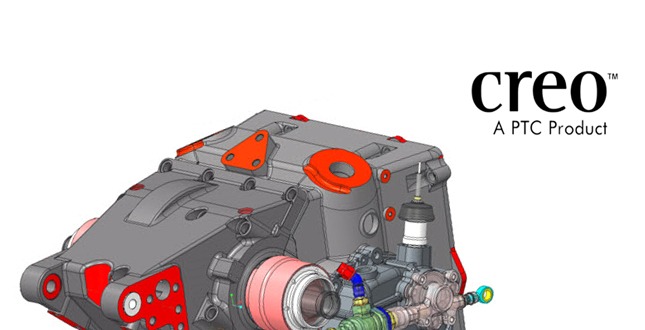Hark! The long awaited day has arrived. PTC Creo is here. Today, Planet PTC begins, and with it, the onslaught of app slapping updates to all the PTC programs you’ve developed product in over the years. They’ve talked about it a lot since the Creo announcement last October. They’ll talk about a lot more, but now they have something to show. Over the next few days more and more details will be revealed about where PTC is taking Creo, but no need to wait, we’ve got a wee bit of it here for you to soak your eyes in.

The PTC Creo Apps
If you’ve wondered what new and amazing products actually comprise the Creo name, if they’re simply the smae programs with new UI’s or where your existing PTC products will fit in for the big switch, you’re not alone. This has been one of the biggest questions since the reformation was announced. There are nine apps slated to be launched in the Creo 1.0 timeframe, seven of which are available as of today. The Creo 1.0 list includes:
- Creo Parametric – For “history-based” modeling with direct and freeform modeling capability.
- Creo Direct – For “history-free” direct modeling to interact directly with the 3D geometry.
- Creo Simulate – A simulation app for thermal and finite element analysis.
- Creo Illustrate – An technical illustration app for communicating model info graphically in 3D.
- Creo Schematics – An app for creating 2D routed systems diagrams, like cabling and piping.
- Creo View MCAD – An app to view, interrogate, and mark up MCAD geometry.
- Creo View ECAD – An app to viewer tailored for electronics.
- Creo Sketch – An app to capture design ideas in 2D. (available July 2011)
- Creo Layout – An app for early concept layout work in 2D, used for 3D. (available Nov 2011)
Creo 2.0 will launch in March of 2012 and you’ll see two more (yet to be announced) apps and, more than likely, Mac OS X support and an iPad app. After this, the PTC Creo apps will slip into an annual release schedule.
From Pro/E to Creo Parametric
The Creo Parametric history-based app replaces what was Pro/Engineer Wildfire and Creo Elements/Pro. It’s history-based, yes, but not completely sketch-driven. Nor is it Pro/Engineer Wildfire or Elements/Pro with a shiny new exterior. There are a lot of new feature, but there are three that completely change what use to be the static Pro/E sketch and extrude workflow. They are the:
- Flexible Modeling Extension (FMX)
- Legacy Migration Extension (LMX)
- Creo Freestyle
The FMX is a $1500 plugin that will be available as a tab on the Creo Parametric UI. FMX allows a user to stay in the same environment and edit models as they would in Creo Direct. Any feature created with FMX in Parametric can also be edited in Creo Direct. The Legacy Migration Extension (LMX) comes as part of Creo Parametric allowing user to bring in legacy CAD data from other modeling programs, automating the transition of the model, view, and annotations, keeping each completely associated with the other. It identifies what models belong to which drawings, what views belong to which models and which dimensions belong to which views. The newest and most anticipated feature for some is the inclusion of Sub-Division (subD) modeling within Creo Parametric. PTC is introducing Freestyle, a fluid modeling tool to shape the geometry as you wish. This comes included as a part of the Creo Parametric package, complete redefining what was formerly possible with previous products.
If you’re interested in seeing Creo parametric in action and learning a bit more about how it works, there are a few Creo Parametric video tutorials available through the PTC University Learning Exchange to get familiar with the interface and learn the basics.


PTC Creo Direct
I’ve gained the most familiarity with Creo Direct over the past few weeks. With a price point (see below) slightly higher than Creo Parametric, it’s sizing up to be PTC’s main 3D development product offering and certainly shows it’s functionality well. While assembly functionality isn’t quite where it needs to be, the basic tools are there to allow work to begin in Direct and bridge the workflow into Creo Parametric to finish. Simple part examples always work well of course, so as you can see in the image below, the boss can be moved about, adjusting instantly to it’s end condition. Some things work better than others. Some features don’t always cut through or overlap, but there’s certainly a lot of direct manipulation power in Creo Direct.



A point to note: Creo Direct is not Creo Elements/Direct (CoCreate) with a new interface. Creo Direct is a separately developed product and where the former and the new product have similar functionality, over time, you will see these converge, to the point where Creo Direct is the only offering. For the time being Creo Elements/Direct will continue to be developed and available for updates. All of this works together as to how the apps are being licensed and delivered.
How is Creo Being Delivered?
PTC’s has had to be careful on this one. Their strategy all along is not to piss customers off make people buy what they already own. Ideally, the transition is seamless with no regression, no data loss and all data and configuration detail upward compatible to Creo. It almost sounds to good to be true when you often get issues from one point release to another, but PTC is convinced the transition will be seamless. For those on maintenance, the same support and version updates remain as they have previously. Above all, no extra cost will be incurred for moving to Creo. For concurrent use license, a similar licensing structure is available for each individual app. For network license use, FlexLM will be used as it had been in the past.
Packages or Suites of apps have yet to be announced, but will become available, the first of which being Creo Engineer Pack 1, set to retail for US $6,000. Each separate app will be priced according to their capability, tailorable for the features needed and scalable for the functionality between each. This is PTC’s way of saying, “We can provide exactly what you need.” As they develop more products in the Creo line, you’ll see packages in the $10,000+ range as well as some apps available for free and still others that will be delivered online and via mobile devices.
Creo on Mac OS X or iPad?
It is coming, but only in bits. The first app you’ll see to support OS X is Creo Sketch. This is planned to be delivered around the Creo 2.0 timeframe (March 2012). Creo Sketch is the the Industrial Design app that allows 2D/3D sketching with output into raster image formats and interoperable with Creo Parametric and Direct. This also the first app slated to be delivered as an iPad app around the same timeframe.
Prior to that, you’ll see Windchill running on the iPad. Due out late 2011, you’ll be able to access all the data as you would in a desktop version of Windchill with the benefit of access via a mobile device. The windchill session is completely delivered over the connection via data located on an Amazon server. The same would be true for a Windows Azure or private server.
Creo App Pricing
Here’s the breakdown of Creo app pricing (all prices in USD, subject to change):
(Pricing to be updated as it is supplied. Check back soon!)
Creo Direct – $4,995 (Entry); ?? (Professional)
Creo Parametric – $3,500
Creo Simulate – ??
Creo Illustrate – ??
Creo Schematic – ??
Creo View MCAD – ??
Creo View ECAD – ??
Creo Sketch (July 2011) – Free
Creo Layout (November 2011) – ??
Conclusion
The PTC Creo product line is very much a new set of programs with more functionality that you’ll see in the previous product lines. The interface now, is cleaner, more simple with just the right amount of similarity needed between apps that had been missing. It’s particularly evident within Creo Parametric and Creo Direct. They’ve brought over the best bits from CoCreate and made it easier to use. They’ve added features to Creo Parametric that will make Pro/Engineer seem archaic. And within both, they are showing how a feature can live in a history-based and a history-free environment, retaining the parametric relation to features within each if intended. When Creo was simply a vision, no one thought users would want to leave their beloved Pro/Engineer. Now, with what PTC is delivering, user may very well want to dump that legacy in the drawer and enjoy all that Creo is beginning to offer.




![6 Types of Civil Engineering Drawings [Detailed Guide]](https://www.solidsmack.com/wp-content/uploads/2023/12/Civil-Engineering-Drawings-270x180.jpeg)

